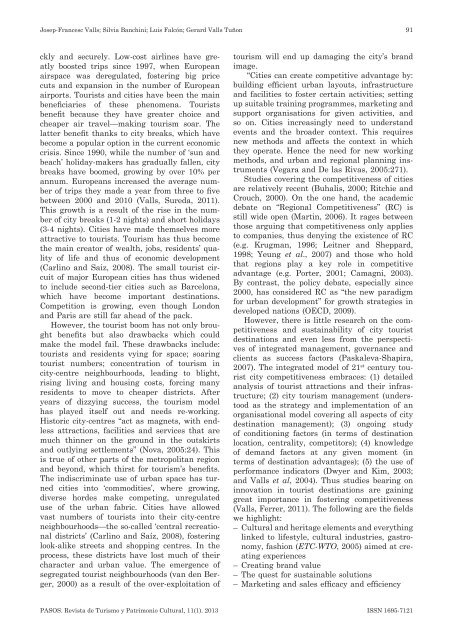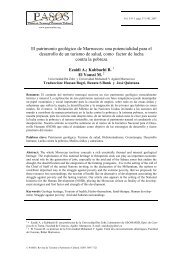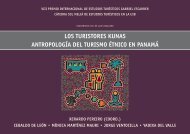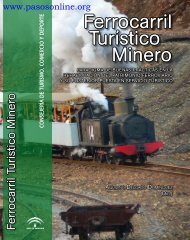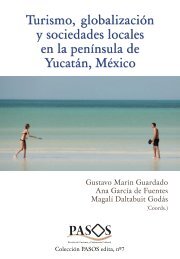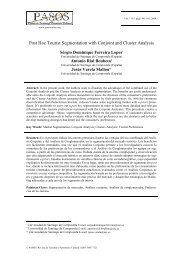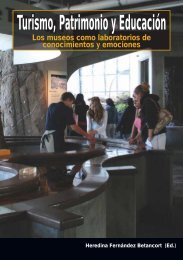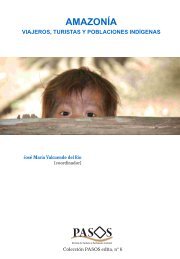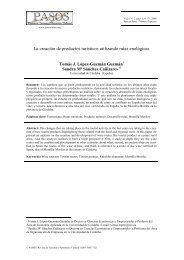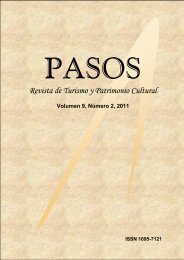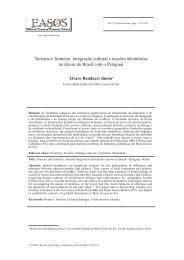Full Journal - Pasos
Full Journal - Pasos
Full Journal - Pasos
You also want an ePaper? Increase the reach of your titles
YUMPU automatically turns print PDFs into web optimized ePapers that Google loves.
Josep-Francesc Valls; Silvia Banchini; Luis Falcón; Gerard Valls Tuñon 91<br />
ckly and securely. Low-cost airlines have greatly<br />
boosted trips since 1997, when European<br />
airspace was deregulated, fostering big price<br />
cuts and expansion in the number of European<br />
airports. Tourists and cities have been the main<br />
beneficiaries of these phenomena. Tourists<br />
benefit because they have greater choice and<br />
cheaper air travel—making tourism soar. The<br />
latter benefit thanks to city breaks, which have<br />
become a popular option in the current economic<br />
crisis. Since 1990, while the number of ‘sun and<br />
beach’ holiday-makers has gradually fallen, city<br />
breaks have boomed, growing by over 10% per<br />
annum. Europeans increased the average number<br />
of trips they made a year from three to five<br />
between 2000 and 2010 (Valls, Sureda, 2011).<br />
This growth is a result of the rise in the number<br />
of city breaks (1-2 nights) and short holidays<br />
(3-4 nights). Cities have made themselves more<br />
attractive to tourists. Tourism has thus become<br />
the main creator of wealth, jobs, residents’ quality<br />
of life and thus of economic development<br />
(Carlino and Saiz, 2008). The small tourist circuit<br />
of major European cities has thus widened<br />
to include second-tier cities such as Barcelona,<br />
which have become important destinations.<br />
Competition is growing, even though London<br />
and Paris are still far ahead of the pack.<br />
However, the tourist boom has not only brought<br />
benefits but also drawbacks which could<br />
make the model fail. These drawbacks include:<br />
tourists and residents vying for space; soaring<br />
tourist numbers; concentration of tourism in<br />
city-centre neighbourhoods, leading to blight,<br />
rising living and housing costs, forcing many<br />
residents to move to cheaper districts. After<br />
years of dizzying success, the tourism model<br />
has played itself out and needs re-working.<br />
Historic city-centres “act as magnets, with endless<br />
attractions, facilities and services that are<br />
much thinner on the ground in the outskirts<br />
and outlying settlements” (Nova, 2005:24). This<br />
is true of other parts of the metropolitan region<br />
and beyond, which thirst for tourism’s benefits.<br />
The indiscriminate use of urban space has turned<br />
cities into ‘commodities’, where growing,<br />
diverse hordes make competing, unregulated<br />
use of the urban fabric. Cities have allowed<br />
vast numbers of tourists into their city-centre<br />
neighbourhoods—the so-called ‘central recreational<br />
districts’ (Carlino and Saíz, 2008), fostering<br />
look-alike streets and shopping centres. In the<br />
process, these districts have lost much of their<br />
character and urban value. The emergence of<br />
segregated tourist neighbourhoods (van den Berger,<br />
2000) as a result of the over-exploitation of<br />
tourism will end up damaging the city’s brand<br />
image.<br />
“Cities can create competitive advantage by:<br />
building efficient urban layouts, infrastructure<br />
and facilities to foster certain activities; setting<br />
up suitable training programmes, marketing and<br />
support organisations for given activities, and<br />
so on. Cities increasingly need to understand<br />
events and the broader context. This requires<br />
new methods and affects the context in which<br />
they operate. Hence the need for new working<br />
methods, and urban and regional planning instruments<br />
(Vegara and De las Rivas, 2005:271).<br />
Studies covering the competitiveness of cities<br />
are relatively recent (Buhalis, 2000; Ritchie and<br />
Crouch, 2000). On the one hand, the academic<br />
debate on “Regional Competitiveness” (RC) is<br />
still wide open (Martin, 2006). It rages between<br />
those arguing that competitiveness only applies<br />
to companies, thus denying the existence of RC<br />
(e.g. Krugman, 1996; Leitner and Sheppard,<br />
1998; Yeung et al., 2007) and those who hold<br />
that regions play a key role in competitive<br />
advantage (e.g. Porter, 2001; Camagni, 2003).<br />
By contrast, the policy debate, especially since<br />
2000, has considered RC as “the new paradigm<br />
for urban development” for growth strategies in<br />
developed nations (OECD, 2009).<br />
However, there is little research on the competitiveness<br />
and sustainability of city tourist<br />
destinations and even less from the perspectives<br />
of integrated management, governance and<br />
clients as success factors (Paskaleva-Shapira,<br />
2007). The integrated model of 21 st century tourist<br />
city competitiveness embraces: (1) detailed<br />
analysis of tourist attractions and their infrastructure;<br />
(2) city tourism management (understood<br />
as the strategy and implementation of an<br />
organisational model covering all aspects of city<br />
destination management); (3) ongoing study<br />
of conditioning factors (in terms of destination<br />
location, centrality, competitors); (4) knowledge<br />
of demand factors at any given moment (in<br />
terms of destination advantages); (5) the use of<br />
performance indicators (Dwyer and Kim, 2003;<br />
and Valls et al, 2004). Thus studies bearing on<br />
innovation in tourist destinations are gaining<br />
great importance in fostering competitiveness<br />
(Valls, Ferrer, 2011). The following are the fields<br />
we highlight:<br />
––<br />
Cultural and heritage elements and everything<br />
linked to lifestyle, cultural industries, gastronomy,<br />
fashion (ETC-WTO, 2005) aimed at creating<br />
experiences<br />
––<br />
Creating brand value<br />
––<br />
The quest for sustainable solutions<br />
––<br />
Marketing and sales efficacy and efficiency<br />
PASOS. Revista de Turismo y Patrimonio Cultural, 11(1). 2013 ISSN 1695-7121


